With student loan payments rolling in, fraudsters often attempt to steal these funds using scams like smishing. Last year alone, millions of pounds were saved from fraud attempts, but the threat remains. As students prepare for the 2024/25 academic year, it’s crucial to raise fraud awareness and learn how to spot these scams.
Smishing scams can lead to identity theft, where fraudsters use your personal details to impersonate you. This can have serious consequences, such as loans being taken out in your name or your bank account being drained. By raising fraud awareness and being cautious with your personal information, you can protect yourself from these risks.
What is Smishing?
Smishing is a type of fraud that uses text messages to trick individuals into giving away their personal and financial details. While phishing typically happens via email, smishing targets users through their mobile phones. Fraudsters send fake messages pretending to be from trusted organisations, like the Student Loans Company (SLC), to steal sensitive information.
In 2023, the SLC prevented the theft of £2.9 million in student loan payments through smishing and phishing scams. This shows just how widespread these scams have become. Fraud prevention starts with recognising the warning signs.
Why Are Students Targeted?
Students are often prime targets for smishing scams, especially when they are about to receive their maintenance loan payments. These loans, provided by the Student Loans Company, help cover living expenses and course-related costs. Fraudsters know that this time of year means large sums of money are being deposited into student bank accounts.
This autumn, the SLC expects to distribute around £2 billion in maintenance loans, making it a prime season for fraudsters. Smishing fraudsters typically send messages that appear to be from the SLC, asking students to verify bank details or provide personal information. Once the student responds, the fraudsters divert the funds to their own accounts.
How to Identify a Smishing Scam
Fraud prevention relies on knowing what to look out for. Smishing messages usually ask the recipient to complete a task, such as verifying bank information. These tasks may seem urgent, making the victim more likely to comply without thinking. Fraudsters use these tactics to steal money or personal data.
According to Alan Balanowski, SLC’s Risk Director, neither the SLC nor Student Finance England will ever ask for personal details via text or email. If you receive such a message, it’s a red flag. He emphasises that fraudsters are especially active during busy periods like the start of the academic year when students are likely juggling various tasks and communications.
What to Do if You Receive a Suspicious Message
The best fraud prevention strategy is simple: “Think before you click.” If you receive a suspicious text message or email, delete it immediately. Never click on links or provide personal information without verifying the source.
Balanowski also stressed the importance of reporting fraud. If a fraudster successfully obtains your personal information, act fast. Report the suspicious activity to your bank and the SLC to block any fraudulent transactions.
Top Tips for Keeping Your Money Safe
Fraud awareness is key to protecting yourself from smishing and other scams. Here are some top tips from the Student Loans Company to help you avoid falling victim to fraudsters:
1. Be Wary of Social Media Messages
The SLC and Student Finance England will never contact students through social media platforms like WhatsApp, Instagram, or TikTok. If you receive a message claiming to be from the SLC, check your official online account to verify its authenticity.
2. Check for Errors
Fraudsters often send poorly written messages with misspellings and grammatical errors. If a message seems suspicious, especially if it arrives around a loan payment date, don’t trust it. Genuine communications from the SLC will address you by your full name and contain accurate details.
3. Think Before You Click
Always verify links in text messages and emails before clicking. Hover over the link to check its destination. If you’re unsure, visit the official website directly rather than using the link. Fraudsters often create fake links that appear legitimate at first glance but lead to fraudulent websites.
4. Use Official Communication Channels
If you need to verify the legitimacy of a message, use official channels. Contact the SLC through their official phone number or online account to confirm any communication. Don’t trust information from unknown sources or unofficial platforms.
5. Protect Your Personal Information
Be mindful of the information you share online. Fraudsters often gather details from social media to impersonate you. Avoid posting personal information like your student loan reference number, course details, or address. This makes it harder for fraudsters to carry out identity theft.
The Importance of Fraud Awareness
Raising fraud awareness is crucial in stopping smishing scams before they succeed. Many victims don’t report fraud due to embarrassment or fear of being blamed. However, reporting fraud helps prevent others from becoming victims and allows banks and institutions to block further fraudulent activity.
Fraud prevention depends on individuals taking action when they suspect something is wrong. By reporting suspicious messages and staying alert to the signs of smishing, students can safeguard their funds and protect their personal information.



